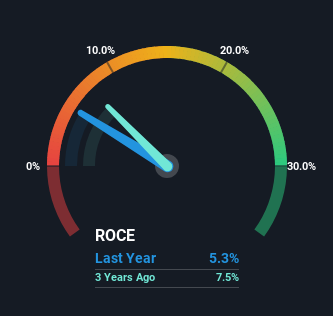- Australia
- /
- Healthcare Services
- /
- ASX:IDX
Some Investors May Be Worried About Integral Diagnostics' (ASX:IDX) Returns On Capital
What trends should we look for it we want to identify stocks that can multiply in value over the long term? Typically, we'll want to notice a trend of growing return on capital employed (ROCE) and alongside that, an expanding base of capital employed. This shows us that it's a compounding machine, able to continually reinvest its earnings back into the business and generate higher returns. In light of that, when we looked at Integral Diagnostics (ASX:IDX) and its ROCE trend, we weren't exactly thrilled.
Return On Capital Employed (ROCE): What Is It?
Just to clarify if you're unsure, ROCE is a metric for evaluating how much pre-tax income (in percentage terms) a company earns on the capital invested in its business. Analysts use this formula to calculate it for Integral Diagnostics:
Return on Capital Employed = Earnings Before Interest and Tax (EBIT) ÷ (Total Assets - Current Liabilities)
0.053 = AU$40m ÷ (AU$839m - AU$83m) (Based on the trailing twelve months to June 2023).
Thus, Integral Diagnostics has an ROCE of 5.3%. On its own, that's a low figure but it's around the 5.6% average generated by the Healthcare industry.
Check out our latest analysis for Integral Diagnostics

Above you can see how the current ROCE for Integral Diagnostics compares to its prior returns on capital, but there's only so much you can tell from the past. If you're interested, you can view the analysts predictions in our free analyst report for Integral Diagnostics .
So How Is Integral Diagnostics' ROCE Trending?
When we looked at the ROCE trend at Integral Diagnostics, we didn't gain much confidence. To be more specific, ROCE has fallen from 18% over the last five years. Although, given both revenue and the amount of assets employed in the business have increased, it could suggest the company is investing in growth, and the extra capital has led to a short-term reduction in ROCE. If these investments prove successful, this can bode very well for long term stock performance.
What We Can Learn From Integral Diagnostics' ROCE
While returns have fallen for Integral Diagnostics in recent times, we're encouraged to see that sales are growing and that the business is reinvesting in its operations. These trends don't appear to have influenced returns though, because the total return from the stock has been mostly flat over the last five years. As a result, we'd recommend researching this stock further to uncover what other fundamentals of the business can show us.
Integral Diagnostics does come with some risks though, we found 3 warning signs in our investment analysis, and 1 of those is potentially serious...
While Integral Diagnostics may not currently earn the highest returns, we've compiled a list of companies that currently earn more than 25% return on equity. Check out this free list here.
New: AI Stock Screener & Alerts
Our new AI Stock Screener scans the market every day to uncover opportunities.
• Dividend Powerhouses (3%+ Yield)
• Undervalued Small Caps with Insider Buying
• High growth Tech and AI Companies
Or build your own from over 50 metrics.
Have feedback on this article? Concerned about the content? Get in touch with us directly. Alternatively, email editorial-team (at) simplywallst.com.
This article by Simply Wall St is general in nature. We provide commentary based on historical data and analyst forecasts only using an unbiased methodology and our articles are not intended to be financial advice. It does not constitute a recommendation to buy or sell any stock, and does not take account of your objectives, or your financial situation. We aim to bring you long-term focused analysis driven by fundamental data. Note that our analysis may not factor in the latest price-sensitive company announcements or qualitative material. Simply Wall St has no position in any stocks mentioned.
About ASX:IDX
Integral Diagnostics
A healthcare services company, provides diagnostic imaging services to general practitioners, medical specialists, and allied health professionals and their patients in Australia and New Zealand.
Reasonable growth potential with slight risk.
Market Insights
Community Narratives



